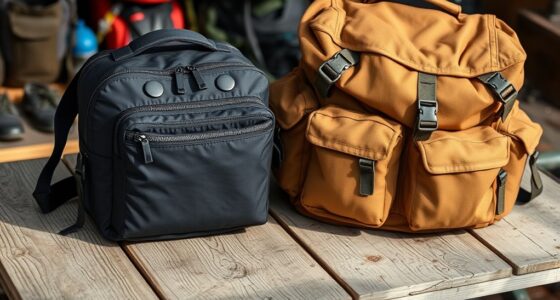To guarantee your water storage never fails, choose durable, food-grade tanks made from high-quality plastics or stainless steel and keep them in cool, shaded areas. Properly clean and sanitize your containers before filling, seal them tightly, and regularly inspect for leaks or mold. Treat stored water with household bleach and rotate supplies every six months. Maintain a consistent schedule for inspection and sanitation, and you’ll secure a safe, dependable water source when you need it most. If you keep exploring, you’ll discover more tips to make your storage foolproof.
Key Takeaways
- Choose durable, food-grade containers made from high-quality plastics or stainless steel for long-term reliability.
- Regularly clean, sanitize, and inspect tanks to prevent contamination, leaks, and mold buildup.
- Store water in cool, shaded, elevated locations to prevent UV damage and ground moisture intrusion.
- Disinfect stored water with household bleach and label containers with fill dates for freshness tracking.
- Implement routine maintenance, water rotation every six months, and proper handling practices to ensure consistent water safety.

Have you ever wondered how to guarantee a steady water supply during emergencies or shortages? It’s a crucial concern, especially when you consider unpredictable situations like natural disasters, power outages, or droughts. Proper water storage isn’t just about filling a few containers; it’s about ensuring your water remains safe, clean, and accessible when you need it most. That’s why choosing reliable storage solutions is essential. You want containers that won’t crack, leak, or degrade over time. Durable, food-grade tanks made from high-quality plastics or stainless steel are your best bet. They resist corrosion and don’t leach harmful chemicals into your water. When selecting storage units, consider size and capacity—larger tanks are great for long-term storage, but they require sturdy placement and maintenance. Smaller containers are easier to handle and rotate, which helps prevent stagnation.
Ensuring your stored water stays safe involves more than just the container; it’s about proper preparation. Before filling your tanks, thoroughly clean and sanitize them to eliminate bacteria or algae. Use food-grade water storage containers and avoid those with previous chemical residues. Once filled, seal your tanks tightly to prevent contamination from dirt, insects, or other pollutants. Position your storage units in cool, shaded areas away from direct sunlight—UV rays can degrade plastics and promote algae growth. Elevating tanks on a sturdy platform helps prevent ground moisture from seeping in and makes dispensing easier. Regularly inspect your tanks for cracks, leaks, or signs of mold. Rotate your water supply every six months to maintain freshness, especially if you’re storing untreated water.
Another critical factor is water treatment. Even stored tap water can contain traces of contaminants. Consider adding a small amount of household bleach—about 8 drops per gallon—to disinfect the water and keep bacteria at bay. Use a clean, food-grade siphon or spigot to draw water, avoiding contamination during dispensing. Label your containers with the date of filling, so you know when to replace or refresh the water. Keep a backup of supplies like extra caps, hoses, and filtration tablets to address unexpected issues. Remember that water storage isn’t a set-it-and-forget-it task; it requires periodic maintenance, proper sanitation, and monitoring.
Frequently Asked Questions
How Often Should I Inspect My Water Storage Containers?
You should inspect your water storage containers at least once a month. Look for cracks, leaks, or signs of contamination like mold or sediment. Check the lids to make sure they’re secure and airtight. Regular inspections help you catch problems early, preventing contamination or failure. Keep the containers clean and sanitized regularly. Staying vigilant ensures your stored water remains safe and ready whenever you need it.
What Materials Are Best for Long-Term Water Storage?
You should choose food-grade plastics like polyethylene or polypropylene for long-term water storage, as they resist leaching and are durable. Stainless steel tanks are also excellent, offering high durability and resistance to corrosion. Avoid materials like regular plastics or painted containers, which can contaminate your water over time. Make certain the containers are opaque to block light and keep water fresh longer, and always clean them thoroughly before use.
Can I Store Water Outdoors in Extreme Weather?
You can store water outdoors in extreme weather, but you need to take precautions. When a storm hits unexpectedly, your water containers might face freezing temperatures or intense heat. To protect your supply, use insulated or UV-resistant containers, and keep them elevated and shaded. Regularly check for leaks or cracks, especially after severe weather. Properly prepared, your water storage can withstand the elements and stay reliable when you need it most.
How Do I Prevent Algae Growth in Stored Water?
You can prevent algae growth in stored water by keeping the container sealed tightly to block sunlight and air, which algae need to thrive. Use opaque or dark-colored containers to limit light exposure, and add a small amount of chlorine or water treatment tablets to inhibit algae growth. Regularly inspect and clean your water storage, replacing it every 6-12 months to guarantee freshness and clarity.
What Is the Ideal Water Capacity for Emergency Storage?
You should aim for at least 52 gallons of emergency water storage per person, enough to last three days. For longer-term preparedness, consider storing 1 gallon per person per day for at least two weeks. Make sure your containers are food-grade, sturdy, and easy to access. Regularly check and rotate your supplies to keep the water fresh, ensuring you’re always ready when an emergency strikes.
Conclusion
When you choose reliable water storage, you’re building a fortress that stands strong against any storm. Think of it as a sturdy vessel, holding life’s essential flow steady and true. With the right setup, you’ll never be left stranded in a dry spell. Trust in quality, and your water supply will be as dependable as the sunrise, always there to nourish and refresh you, no matter what challenges come your way.










